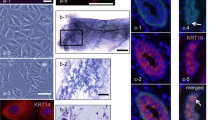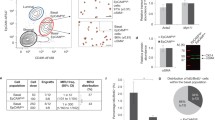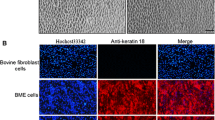Abstract
Methods are described for the isolation, purification, and culture of bovine mammary epithelial cells. Individual cells were microinjected with a plasmid bearing the sequence for the simian virus 40 early region mutant tsA58 which encodes the thermolabile large T-antigen. After selection in G418-containing medium, surviving colonies were recovered and recloned. One of the clones, designated (E-TC), has been cultured for more than 300 population doublings and exhibits some very unusual properties. From low to middle confluency, E-TC cells exhibit the typical cobblestone morphology of epithelial cells. When E-TC cells remain in culture for 2 weeks, the majority of the cells in a single colony maintain the epithelial cobblestone-like morphology but cells at the periphery of the colony become larger, elongated, and less compact, a morphology more typical of myoepithelial-like cells. Myoepithelial cells, in co-culture, always surround epithelial cells (Zavizion et al., J. Dairy Sci. 75: 3381-3392). In co-culture with the BMM-UV bovine myoepithelial cells, E-TC cells are surrounded by the BMM-UV myoepithelial cells, thus the ET-C cells exhibit epithelial-like behavior. In co-culture with the MAC-T bovine epithelial cells, E-TC cells surround the MAC-T cells, thus the ET-C cells exhibit myoepithelial-like behavior. This suggests that E-TC cells may represent an immortalized bovine mammary stem cell (or precursor) which can exhibit myoepithelial-or epithelial-like properties depending upon certain culture conditions.
Similar content being viewed by others
References
Larson BL. Biosynthesis and cellular secretion of milk. In: Larson BL, ed. Lactiation. Iowa: The Iowa State University Press, 1985: 129–163.
Stamps AC, Davies SC, Burman J, O'Tare MJ. Analysis of proviral integration in human mammary epithelial cell lines immortalized by retroviral infection with a temperature-sensitive SV40 T-antigen construct. Int J Cancer 1994; 57: 865–874.
Crepin M, Gamby C, Salle V, Souttou B, Tamboise A, Tamboise E, Hamelin R. Phenotypes of human epithelial cell lines immortalized from benign mastopathies. Anticancer Res 1993; 13: 497–506.
Ghosh SK, Roholt OA, Kim U. Establishment of two non-metastasizing and one metastasizing rat mammary carcinoma cell lines. In Vitro Cell Dev Biol 1993; 19: 919–927.
Raux H, Planchon P, Chraibi-Hajji F, Magnien V, Salle V, Brouty-Boye D. Immunophenotype of SV40-T gene transfected epithelial cell lines derived from human benign breast tumors. In Vitro Cell Dev Biol 1992; 28A: 468–470.
Soule HD, Maloney TM, Wolman SR, Peterson WD, Brenz R, McGrath CM, Russo J, Pauley RJ, Jones RF, Brooks SC. Isolation and characterization of a spontaneously immortalized human breast epithelial cell line, MCF-10. Cancer Res 1990; 50: 6075–6086.
Reichmann E, Ball R, Groner B, Friis RR. New mammary epithelial and fibroblastic cell clones in coculture form structures competent to differentiate functionally. J Cell Biol 1989; 108: 1127–1138.
Seitz PK, Cooper KM, Ives KL, Ishizuka J, Townsend CM, Rajaraman S, Cooper CW. Parathyroid hormonerelated peptide production and action in a myoepithelial cell line derived from normal human breast. Endocrinology 1993; 133: 1116–1124.
Sapino A, Papotti M, Sanfilippo B, Gugliotta P, Bussolati G. Tumor types derived from epithelial and myoepithelial cell lines of R3230AC rat mammary carcinoma. Cancer Res 1992; 52: 1553–1560.
Petersen OW, Van Deurs B. Growth factor control of myoepithelial-cell differentiation in cultures of human mammary gland. Differentiation 1988; 39: 197–215.
Warburton MJ, Ferns SA, Hughes CM, Sear CH, Rudland PS. Generation of cell types with myoepithelial and mesenchymal phenotypes during the conversion of rat mammary tumor epithelial stem cells into elongated cells. JNCI 1987; 78: 1191–1201.
Huynh HT, Robitaille G, Turner JD. Establishment of bovine mammary epithelial cells (MAC-T): an in vitro model for bovine lactation. Exp Cell Res 1991; 197: 191–199.
Hung H, Pollak M. HH2A, an immortalized bovine mammary epithelial cell line, expresses the gene encoding mammary derived growth inhibitor (MDGI). In Vitro Cell Dev Biol 1995; 31A: 25–29.
Zavizion B, van Duffelen M, Schaeffer W, Politis I. Establishment and characterization of a bovine mammary epithelial cell line with unique properties. In Vitro Cell Dev Biol 1995 (in press).
Zavizion B, Van Duffelen M, Schaeffer W, Politis I. Establishment and characterization of a bovine mammary myoepithelial cell line. In Vitro Cell Dev Biol 1995 (in press).
Hellmen E. Characterization of four in vitro established canine mammary carcinoma and one atypical benign mixed tumor cell lines. In Vitro Cell Dev Biol 1992; 28A: 309–319.
Rudland PS, Paterson C, Monaghan P, Twiston DAC, Warburton MJ. Isolation and properties of rat cell lines morphologically intermediate between cultured mammary epithelial and myoepithelial-like cells. Dev Biol 1986; 113: 388–405.
Paterson FC, Rudland PS. Identification of novel, stage-specific polypeptides associated with the differentiation of mammary epithelial stem cells to alveolar-like cells in culture. J Cell Phys 1985; 124: 525–538.
Whitehead RH, Bertoncello I, Webber LM, Pedersen JS. A new human breast carcinoma cell line (PMC42) with stem cell characteristic. I. Morphological characterization. JNCI 1983; 70: 649–661.
Ruland PS, Ollerhead G, Barraclough R. Isolation of simian virus 40-transformed human mammary epithelial stem cell lines that can differentiate to myoepithelial-like cells in culture and in vivo. Dev Biol 1989; 136: 167–180.
Williams JM, Daniel CW. Mammary duct elongation: differentiation of myoepithelium and basal lamina during branching morphogenesis. Dev Biol 1983; 97: 274–290.
Dulbecco R, Henahan M, Armstrong B. Cell types and morphogenesis in the mammary gland. Proc Natl Acad Sci USA 1982; 79: 7346–7350.
Jat PS, Sharp PA. Cell lines established by a temperature-sensitive simian virus 40 large T-antigen gene are growth restricted at the nonpermissive temperature. Mol Cell Biol 1989; 9: 1672–1681.
Graessmann A, Graessmann M, Mueller C. Microinjection of early SV40 DNA fragments and T antigen. Meth Enzymol 1980; 65: 816–825.
Zavizion B, Politis I, Gorewit RC. Bovine mammary myoepithelial cells. 1. Isolation, culture and characterization. J Dairy Sci 1992; 75: 3367–3380.
Shay JW, Van Der Haegen BA, Ying Y, Wright WE. The frequency of immortalization of human fibroblasts and mammary-epithelial cells transfected with SV40 large T-antigen. Exp Cell Res 1993; 209: 45–52.
Poliard A, Lamblin D, Plee E, Forest C, Kellermann O. Controlled conversion of an immortalized mesodermal progenitor cell towards osteogenic, chondrogenic, or adipogenic pathways. J Cell Biol 1995; 130: 1461–1472.
Zavizion B, Politis I, Gorewit RC. Bovine mammary myoepithelial cells. 2. Interactions with epithelial cells in vitro. J Dairy Sci 1992; 75: 3381–3392.
Heim I, Gabay JA, Garcia I. Selective immortalization of mammary epithelial cells by microinjection of SV40 DNA into human milk cells. Meths in Cell Biol 1995; 17(2): 91–96.
Author information
Authors and Affiliations
Corresponding author
Rights and permissions
About this article
Cite this article
Zavizion, B., Van Duffelen, M., Schaeffer, W. et al. Use of microinjection to generate an immortalized bovine mammary cell line with both epithelial and myoepithelial characteristics. Methods Cell Sci 17, 271–282 (1995). https://doi.org/10.1007/BF00986233
Accepted:
Issue Date:
DOI: https://doi.org/10.1007/BF00986233




